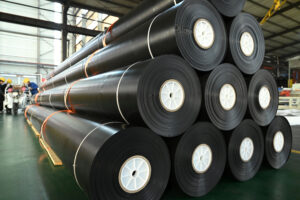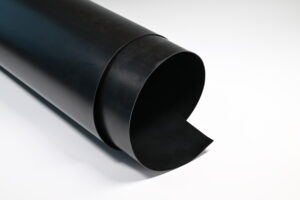The geomembrane fusion covering method is a commonly used method for making geomembranes. It is suitable for on-site construction, and the purpose of soil seepage prevention and soil protection is achieved by coating the melted geomembrane material on the soil surface.
The production process of geomembrane fusion covering method
Material preparation: Select suitable geomembrane materials, common materials include high-density polyethylene (HDPE) and linear low-density polyethylene (LLDPE). These materials are usually supplied in pellet, powder or coil form and require pre-treatment and heating as required.
Heating and melting: The geomembrane material is heated and melted, usually using dedicated heating equipment such as a welding gun or a coater. The heating temperature is adjusted according to the material type and thickness to bring the geomembrane to a molten state.

Coating the soil surface: Coating the molten geomembrane material on the soil surface that needs anti-seepage or protection. Can be applied using manual or mechanical equipment. Pay attention to uniformity and coverage when applying to ensure that the soil surface is adequately covered.
Cooling and solidification: The geomembrane coated on the soil surface will quickly solidify through natural cooling and combine with the soil surface during the solidification process. Cooling times will vary based on material type and environmental conditions. After cooling and curing, the geomembrane forms a continuous barrier or soil protection layer.
Inspection and maintenance: The coated geomembrane is inspected to ensure that its quality and coverage performance meet the requirements. During the construction process, also pay attention to cleaning the surface impurities and checking the connection between the coating layer and the concrete or other structures in the surrounding environment.
The advantages of the geomembrane fusion covering method include simple construction, strong applicability, and applicability to irregular surfaces. It is suitable for occasions requiring on-site soil seepage prevention, soil protection, and isolation layers. However, it should be noted that the construction technology requirements of the fusion coating method are relatively high, and experienced construction personnel are required to operate to ensure that the quality and performance of the coating layer meet the expected requirements.
Geomembrane sewing method is a commonly used method of making geomembrane. It uses a special geomembrane sewing machine to sew prefabricated geomembrane blocks or coils to achieve soil seepage prevention, isolation layers and other applications.

Process steps of geomembrane sewing method
Material preparation: Select suitable geomembrane materials, common materials include high-density polyethylene (HDPE) and linear low-density polyethylene (LLDPE). These materials are usually supplied in the form of rolls, which are cut into film blocks of the required size and shape in advance as needed.
Sewing machine debugging: According to the thickness and characteristics of the geomembrane material, adjust the settings of the geomembrane sewing machine, including wire tension, stitch spacing, stitch type, etc. Make sure the machine is functioning properly and is able to produce stable seams.
Sewing operation: Place the prefabricated geomembrane block or roll on the workbench of the geomembrane sewing machine, and align the edges of the block or roll according to the arrangement and sewing requirements. Use a sewing machine to sew the two layers of film together tightly.
Sewing quality control: During the sewing process, the stability and quality of the sutures must be ensured to avoid broken, loose or irregular threads. For special engineering needs, strengthening treatment or protection measures may be required, such as adding reinforcement materials or adhesives at the seams.
Sewing seam treatment: After sewing is completed, check the seam and perform necessary treatment. Often hot-melt welding or special adhesives can be used to enhance the seal and firmness of the seams. Ensure that the anti-seepage performance of the joints meets the requirements.

Inspection and maintenance: inspect the sewn geomembrane to ensure its quality and performance meet the requirements. Pay attention to check the seam and surrounding area to ensure the integrity of the suture and the leak-proof effect.
The geomembrane sewing method is suitable for making larger geomembrane segments or for applications requiring higher strength connections. It has the advantages of convenient construction and can be applied to irregularly shaped land. However, during the sewing process, it is necessary to pay attention to the operating specifications to ensure the quality and performance of the seam. For special engineering needs and material requirements, it may be necessary to use other reinforcement materials or special stitching techniques to improve the anti-seepage and protection effect of the geomembrane.


